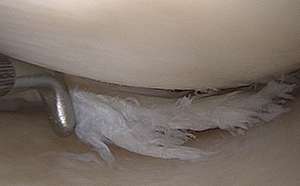Obesity, aging genes may play role in arthritis

(Medical Xpress)—Studying gene activity in tissue removed from injured knees, researchers at Washington University School of Medicine in St. Louis have found that genes related to obesity and aging may contribute to the development of osteoarthritis.
Osteoarthritis is the most common knee disorder. The problem involves the breakdown of cartilage, causing pain, swelling and stiffness that make it difficult, over time, to move the joint or put weight on it.
The new study involved 68 people who had surgery to repair or remove a torn meniscus, the cartilage in the knee that acts as a cushion between the shinbone and the thighbone. The findings are available online in the International Journal of Obesity.
"Having a tear in the meniscus is associated with an increased risk of developing osteoarthritis later in life," says principal investigator Robert H. Brophy, MD. "Some studies have suggested that more than 50 percent of people with a meniscus tear will go on to develop arthritis 10 to 20 years later, but we don't precisely understand how one leads to the other."
For the study, Brophy, a sports medicine specialist and associate professor of orthopaedic surgery, and M. Farrooq Rai, PhD, postdoctoral research scholar in orthopaedic surgery, analyzed the activity of 28 genes related to obesity, aging and the secretion of inflammatory substances in meniscus tissue to learn how genes related to age and body mass might influence the development of arthritis.
"We know there's a mechanical relationship," he says. "People who are obese have increased pressure and force on the knee joint. And older people have more wear and tear on the joints. But we wanted to see whether something else is going on that may accelerate the risk for osteoarthritis."
Brophy and his colleagues found four aging-related genes and one obesity-related gene behaving abnormally in torn meniscus tissue. Heavy patients had low activity levels in the obesity gene, and older patients had low activity in aging-related genes. Low activity in the genes may contribute to disease by leaving the tissue without enough of the proteins necessary for the meniscus to function normally.
The researchers also noticed differences in the activity of genes involved in degrading tissue and increasing inflammation levels.
"In general, I think we can say that the inflammatory molecules we see in the tissue are not good," says co-investigator Linda J. Sandell, PhD. "The meniscus is a stable, slowly changing tissue. But if it's overstimulated, that usually means it's being irritated in some way. What we don't know at this point is whether the meniscus is irritated because it was torn by injury or whether it's responding to something else. It's even possible that the tissue tore because it already was in a pre-osteoarthritis condition."
Sandell, the Mildred B. Simon Research Professor of Orthopaedic Surgery, leads the Center for Musculoskeletal Research and also serves as president of the Osteoarthritis Research Society. This project, like much of her research, is directed at finding markers for osteoarthritis before patients actually develop symptoms. The meniscus is a key focus of those studies, and she's particularly excited that these genetic and molecular studies are being conducted in human tissue.
"These findings are directly applicable to human disease," she says. "We're beginning to learn that the meniscus itself is manufacturing things that could degrade tissue in the knee, so it may be an active player in osteoarthritis. Unfortunately, many drug companies aren't excited about developing drugs to inhibit osteoarthritis until we can show that it's possible to detect it early."
The current study looked primarily at the activity of genes already suspected of being involved in the development of osteoarthritis. But Sandell and Brophy say their next step involves analyzing every gene that's active in meniscus tissue. They'll also continue to follow patients to see whether it's possible to connect the dots that link genetic and molecular markers in the meniscus to clinical outcomes in patients.
More information: International Journal of Obesity, advance online publication. doi:10,1038/ijo.2012.221
















